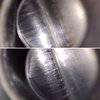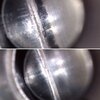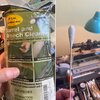Nature Boy
Member
- Joined
- Apr 21, 2015
- Messages
- 8,244
I was cleaning a few rifles this weekend I was able to get some good examples of what a carbon ring looks like so I thought it would be worth a post on the subject.
When it comes to the subject of carbon rings, some folks may not even know about. Perhaps they have heard about it but don’t know where it is, why they should worry about it or what to do to address it.
Then there’s a high likelihood that some of you know more than I do about carbon rings and will let me know that I don’t have a clue.
Regardless, all points of view are welcome.
The carbon ring I’m referring to develops in the chamber where the case mouth ends, right before the chamfer and transition to the throat

Some folks will refer to the carbon ring as any hard carbon deposits that forms from the case mouth through the first few inches of the barrel. I’m focusing specifically on this:

I believe that cleaning the chamber is an often overlooked area when it comes to rifle maintenance (I know it has been for me) If not addressed, this carbon deposit will build up to a point where it impinges on the case causing pressure variations and degrading accuracy. Like any hard carbon (not powder fouling) the longer it goes, the more difficult it will be to clean it out.
As I stated above, I was cleaning a couple of .308s I was able to get some good before and after pics


The deposits shown formed after around 100 rounds, so it doesn’t take much to start building up.
There are several effective methods to get at it. A good chamber brush. A patch wrapped on a jag with a bore cleaning compound. An over sized bore bush. Regardless, it requires a combination of mechanical action and cleaning products to remove it. Solvents alone won’t touch it.
My favorite technique is to use these Ramrodz. In regards to .308 based chambers, the 45 cal size is perfect

I soak the “Q-Tip” with Boretech carbon remover and insert it in the chamber and let it sit in there for an hour or so.

After that, I’ll work the Ramrodz back a forth and spin it until I’ve gotten the deposit completely removed.
Now, if I let it go for a few hundred rounds this method is less effective. It usually requires a chamber brush and some form of bore cleaning compound like JB, Iosso or Flitz.
I hope some find this helpful
When it comes to the subject of carbon rings, some folks may not even know about. Perhaps they have heard about it but don’t know where it is, why they should worry about it or what to do to address it.
Then there’s a high likelihood that some of you know more than I do about carbon rings and will let me know that I don’t have a clue.
Regardless, all points of view are welcome.
The carbon ring I’m referring to develops in the chamber where the case mouth ends, right before the chamfer and transition to the throat

Some folks will refer to the carbon ring as any hard carbon deposits that forms from the case mouth through the first few inches of the barrel. I’m focusing specifically on this:

I believe that cleaning the chamber is an often overlooked area when it comes to rifle maintenance (I know it has been for me) If not addressed, this carbon deposit will build up to a point where it impinges on the case causing pressure variations and degrading accuracy. Like any hard carbon (not powder fouling) the longer it goes, the more difficult it will be to clean it out.
As I stated above, I was cleaning a couple of .308s I was able to get some good before and after pics


The deposits shown formed after around 100 rounds, so it doesn’t take much to start building up.
There are several effective methods to get at it. A good chamber brush. A patch wrapped on a jag with a bore cleaning compound. An over sized bore bush. Regardless, it requires a combination of mechanical action and cleaning products to remove it. Solvents alone won’t touch it.
My favorite technique is to use these Ramrodz. In regards to .308 based chambers, the 45 cal size is perfect

I soak the “Q-Tip” with Boretech carbon remover and insert it in the chamber and let it sit in there for an hour or so.

After that, I’ll work the Ramrodz back a forth and spin it until I’ve gotten the deposit completely removed.
Now, if I let it go for a few hundred rounds this method is less effective. It usually requires a chamber brush and some form of bore cleaning compound like JB, Iosso or Flitz.
I hope some find this helpful


